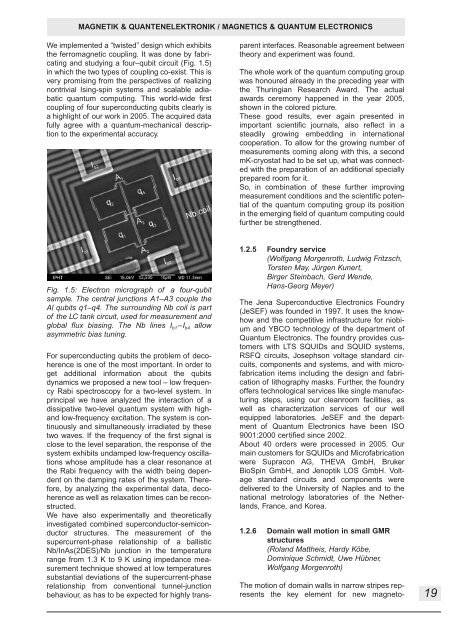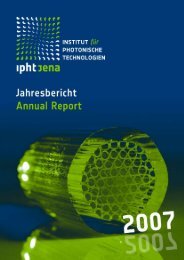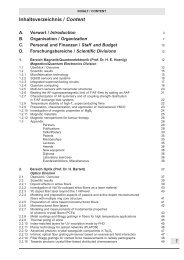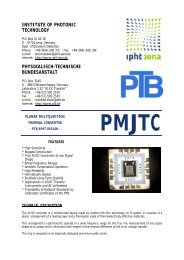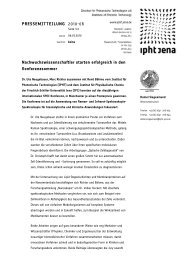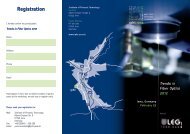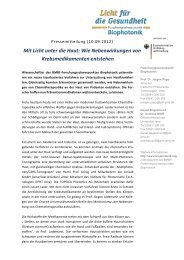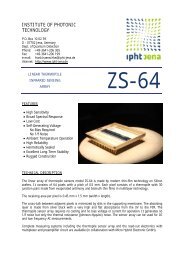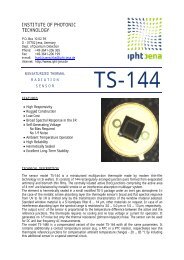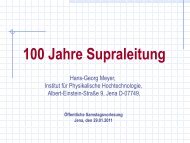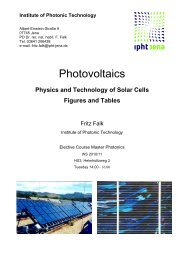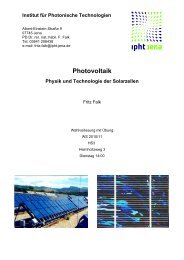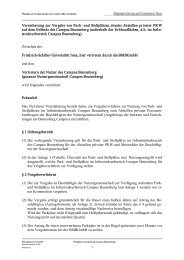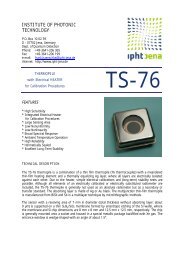Jahresbericht 2005 - IPHT Jena
Jahresbericht 2005 - IPHT Jena
Jahresbericht 2005 - IPHT Jena
Create successful ePaper yourself
Turn your PDF publications into a flip-book with our unique Google optimized e-Paper software.
MAGNETIK & QUANTENELEKTRONIK / MAGNETICS & QUANTUM ELECTRONICS<br />
We implemented a “twisted” design which exhibits<br />
the ferromagnetic coupling. It was done by fabricating<br />
and studying a four–qubit circuit (Fig. 1.5)<br />
in which the two types of coupling co-exist. This is<br />
very promising from the perspectives of realizing<br />
nontrivial Ising-spin systems and scalable adiabatic<br />
quantum computing. This world-wide first<br />
coupling of four superconducting qubits clearly is<br />
a highlight of our work in <strong>2005</strong>. The acquired data<br />
fully agree with a quantum-mechanical description<br />
to the experimental accuracy.<br />
Fig. 1.5: Electron micrograph of a four-qubit<br />
sample. The central junctions A1–A3 couple the<br />
Al qubits q1–q4. The surrounding Nb coil is part<br />
of the LC tank circuit, used for measurement and<br />
global flux biasing. The Nb lines I b1–I b4 allow<br />
asymmetric bias tuning.<br />
For superconducting qubits the problem of decoherence<br />
is one of the most important. In order to<br />
get additional information about the qubits<br />
dynamics we proposed a new tool – low frequency<br />
Rabi spectroscopy for a two-level system. In<br />
principal we have analyzed the interaction of a<br />
dissipative two-level quantum system with highand<br />
low-frequency excitation. The system is continuously<br />
and simultaneously irradiated by these<br />
two waves. If the frequency of the first signal is<br />
close to the level separation, the response of the<br />
system exhibits undamped low-frequency oscillations<br />
whose amplitude has a clear resonance at<br />
the Rabi frequency with the width being dependent<br />
on the damping rates of the system. Therefore,<br />
by analyzing the experimental data, decoherence<br />
as well as relaxation times can be reconstructed.<br />
We have also experimentally and theoretically<br />
investigated combined superconductor-semiconductor<br />
structures. The measurement of the<br />
supercurrent-phase relationship of a ballistic<br />
Nb/InAs(2DES)/Nb junction in the temperature<br />
range from 1.3 K to 9 K using impedance measurement<br />
technique showed at low temperatures<br />
substantial deviations of the supercurrent-phase<br />
relationship from conventional tunnel-junction<br />
behaviour, as has to be expected for highly trans-<br />
parent interfaces. Reasonable agreement between<br />
theory and experiment was found.<br />
The whole work of the quantum computing group<br />
was honoured already in the preceding year with<br />
the Thuringian Research Award. The actual<br />
awards ceremony happened in the year <strong>2005</strong>,<br />
shown in the colored picture.<br />
These good results, ever again presented in<br />
important scientific journals, also reflect in a<br />
steadily growing embedding in international<br />
cooperation. To allow for the growing number of<br />
measurements coming along with this, a second<br />
mK-cryostat had to be set up, what was connected<br />
with the preparation of an additional specially<br />
prepared room for it.<br />
So, in combination of these further improving<br />
measurement conditions and the scientific potential<br />
of the quantum computing group its position<br />
in the emerging field of quantum computing could<br />
further be strengthened.<br />
1.2.5 Foundry service<br />
(Wolfgang Morgenroth, Ludwig Fritzsch,<br />
Torsten May, Jürgen Kunert,<br />
Birger Steinbach, Gerd Wende,<br />
Hans-Georg Meyer)<br />
The <strong>Jena</strong> Superconductive Electronics Foundry<br />
(JeSEF) was founded in 1997. It uses the knowhow<br />
and the competitive infrastructure for niobium<br />
and YBCO technology of the department of<br />
Quantum Electronics. The foundry provides customers<br />
with LTS SQUIDs and SQUID systems,<br />
RSFQ circuits, Josephson voltage standard circuits,<br />
components and systems, and with microfabrication<br />
items including the design and fabrication<br />
of lithography masks. Further, the foundry<br />
offers technological services like single manufacturing<br />
steps, using our cleanroom facilities, as<br />
well as characterization services of our well<br />
equipped laboratories. JeSEF and the department<br />
of Quantum Electronics have been ISO<br />
9001:2000 certified since 2002.<br />
About 40 orders were processed in <strong>2005</strong>. Our<br />
main customers for SQUIDs and Microfabrication<br />
were Supracon AG, THEVA GmbH, Bruker<br />
BioSpin GmbH, and Jenoptik LOS GmbH. Voltage<br />
standard circuits and components were<br />
delivered to the University of Naples and to the<br />
national metrology laboratories of the Netherlands,<br />
France, and Korea.<br />
1.2.6 Domain wall motion in small GMR<br />
structures<br />
(Roland Mattheis, Hardy Köbe,<br />
Dominique Schmidt, Uwe Hübner,<br />
Wolfgang Morgenroth)<br />
The motion of domain walls in narrow stripes represents<br />
the key element for new magneto-<br />
19


